Classe 2^B – Scuola Primaria “A. Ciancia” – Francavilla in Sinni (PZ) – Italia
Happy Befana! / Buona Befana!
January 19, 2011MERRY CHRISTMAS! / BUON NATALE!
January 19, 2011Classe 2^B – ScuolaPrimaria “A. Ciancia” – Francavilla in Sinni (PZ) – Italia
Christmas 2010 at school/ Natale 2010 a scuola
January 19, 2011
Classe 2^B -Scuola Primaria “A. Ciancia”-Francavilla in Sinni (PZ) – Italia
2010 in review
January 2, 2011The stats helper monkeys at WordPress.com mulled over how this blog did in 2010, and here’s a high level summary of its overall blog health:

The Blog-Health-o-Meter™ reads Wow.
Crunchy numbers
The average container ship can carry about 4,500 containers. This blog was viewed about 18,000 times in 2010. If each view were a shipping container, your blog would have filled about 4 fully loaded ships.
In 2010, there were 4 new posts, growing the total archive of this blog to 214 posts. There were 3 pictures uploaded, taking up a total of 2mb.
The busiest day of the year was December 14th with 375 views. The most popular post that day was Christmas food in Ireland.
Where did they come from?
The top referring sites in 2010 were en.wordpress.com, search.conduit.com, letspracticeenglishtogether.blogspot.com, iteach.ro, and search-results.com.
Some visitors came searching, mostly for torrone, wren, wren bird, webcam, and christmas in austria.
Attractions in 2010
These are the posts and pages that got the most views in 2010.
Christmas food in Ireland December 2007
4 comments
Torrone, an Italian Christmas dessert December 2007
2 comments
Money for the Starving Wren December 2007
Christmas in Austria December 2007
Wren Boys Procession December 2007
3 comments
The Befana’s legend / La leggenda della Befana
January 15, 2010Hurray! Hurray For the Befana! / Viva viva la Befana!
January 11, 2010
Classe 1^B – Scuola primaria “A. Ciancia” – Francavilla in Sinni (PZ)-Italia
The Bear – Ancient New Year Tradition in Romania
January 3, 2010Christmas and New Year in Romania Seen through a Foreigner’s Eyes
January 3, 2010Along the last two years we have described our Christmas and New Year traditions as we, as Romanians, see and understand them. This year, besides this, I thought of asking a foreigner to do it. Ms Natalie Montanaro, an American Peace Corps volunteer in Brusturoasa, Romania, helped me with this and I would like to thank her for her effort and to wish her and everybody here a HAPPY NEW YEAR (and Easy Recession!).
It is my pleasure to be here in this place and to share these times as a Peace Corps volunteer with the Romanian people in Brusturoasa and its surrounding communities. It has been the single most wonderful holiday experience I have ever had. And it couldn’t have come at a better time. Being away from home is harder than I imagined, but life and God (and Santa, too) always seem to bring the gifts that you need the most when you least expect them. By the way, our bear “costumes” here in the village as you can see were actual bear skins-paws, teeth and all. Any taxidermist would be proud. The entire event was a unique combination of an “Ancient and Horribles” parade, majestic rodeo-style equine processions, old-fashioned European spirited holiday cabaret chorals in traditional hand-made Romanian dress, hilarious comical renderings with cowbells, flutes, drums and horns along with history-relating theatrical ditties reminiscent of Shakespearean lore both by children and adults. All of it ending off three hours later with American-Indian-like rain dances in the dark accompanied by a Fourth of July fireworks finale above enough to shed light on the snow-covered mountains turning red, blue, and yellow as faces in the crowd watched in amazement. We all walked to our homes together following the procession as it trailed away from a huge mass gathering to variously sized groups of friends, neighbors, and happy children saying goodnight and praising the talents and efforts of all who performed. You really haven’t lived until you’ve paraded with the bears—Fabulously Frenetic!! The following is a portion of an article regarding Romanian Christmas traditions, including the steaua, colinde, and the jocul ursului (bear and comics parade), that occur during the holidays here, some of which are unique to the region of Moldova. The original post can be found at http://www.bucurestiwww.ro The Village Way: Romanian Christmas traditions are based around the idea of time, explains Ion Blajan, head of collections at the Peasant Museum (Muzeul Taranului Roman): the traditional tales and celebrations are based on a 12-day period in which life goes through a chaotic period then starts afresh in the New Year. The practices that surround these traditions are now mostly seen in Northern Romania, around Bucovina and Suceava, and especially in Campulung Moldovenesc. Blajan explains the stories behind them: Romanians believe there is a period of chaos, where the world is broken and anything is possible; dead souls can come back to the earth, and we can communicate between our two worlds, the underworld and the sky. All this is reflected in dancing and songs and parades, and there is no regard for anything serious while it’s going on. Sounds just like a New Year’s Eve in London to me! On the last day, when all the celebrations finish, people beat the bushes where they believe dead souls are hiding. They believe the souls must go back to their world or else they’ll threaten people on earth. It may sound like something your mother warned you away from, but the result is a wonderfully creative expression of tradition, with children in amazing costumes, so cleverly constructed and imaginative they could well be on a theatre stage, accompanied by sweet-sounding songs as well as miming and parades. Blajan continues: After the chaos, Christ is born, and from the chaos is born a new world. Children go around with a star and sing songs about the birth of Jesus Christ. Specific activities happen on each of the 12 days, says Blajan: On Christmas Eve the day is very short, and it was thought the sun would die, so a fire is lit on a wheel, which looks like the sun, to help the sun rise again, because without the sun the world would die. On New Year’s Eve there are parades in the villages with bands and everyone wears costumes and masks. There are bride and groom masks, which symbolise a new life, and masks of old men and women which represent the old year. Some children dress up as bears – in the past real bears on leashes were led by gyp sies in parades, but now sheep or bear skin costumes are used. Often the parade features goats, horses, deer and other animals pulled along on wheels as part of the parade with the band and the rest of the characters in the masks. Then on the last day, January 7th, children go to each house and sing songs about the baptism of St John. *WISHING ALL OF YOU BOTH NEAR AND FAR THE MOST BLESSED OF HOLIDAY SEASONS!
Under the tree!/ Sotto l’albero!
December 26, 2009Describing Christmas / Descrivendo il Natale
December 26, 2009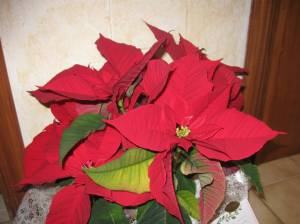
buono come i “Panzerotti con le castagne” as good as the “Chestnuts pancakes“
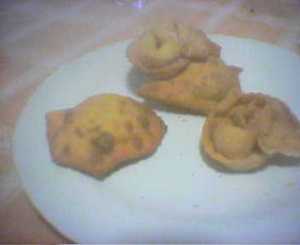
bianco come la neve as white as the snow
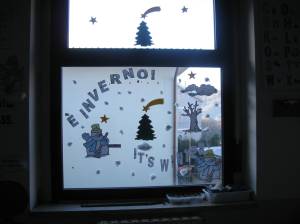
santo come Gesù Bambino
as holy as Baby Jesus
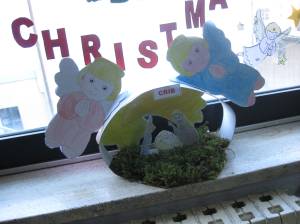
luminoso e colorato come l’albero di Natale
as brigth and coloured as the Christmas Tree
dolce come il Panettone
as sweet as the Panettone
Gina e la Classe 1^B -Scuola Primaria “A. Ciancia” – Francavilla in Sinni (PZ) -Italia
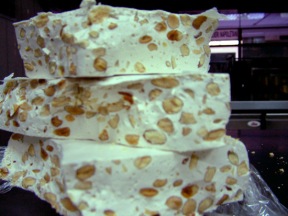

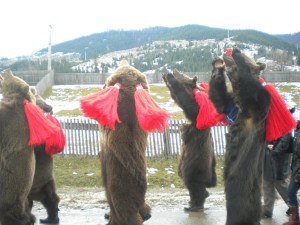

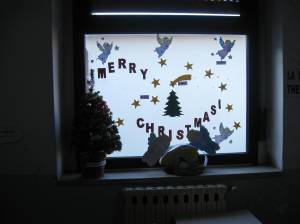
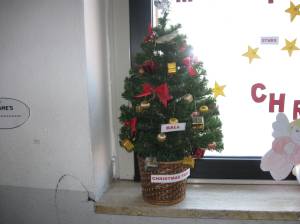
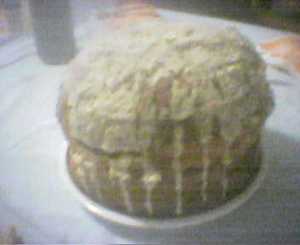










You must be logged in to post a comment.